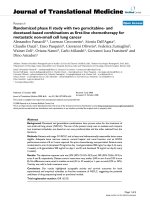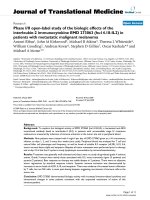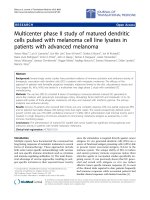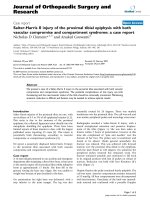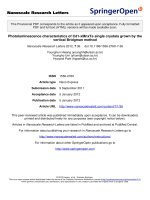Báo cáo toán học: " Pseudorandom recursions II" pdf
Bạn đang xem bản rút gọn của tài liệu. Xem và tải ngay bản đầy đủ của tài liệu tại đây (256.72 KB, 49 trang )
This Provisional PDF corresponds to the article as it appeared upon acceptance. Fully formatted
PDF and full text (HTML) versions will be made available soon.
Pseudorandom recursions II
EURASIP Journal on Embedded Systems 2012, 2012:1 doi:10.1186/1687-3963-2012-1
Laszlo Hars ()
Gyorgy Petruska ()
ISSN 1687-3963
Article type Research
Submission date 25 July 2011
Acceptance date 1 February 2012
Publication date 1 February 2012
Article URL />This peer-reviewed article was published immediately upon acceptance. It can be downloaded,
printed and distributed freely for any purposes (see copyright notice below).
For information about publishing your research in EURASIP Journal on Embedded Systems go to
/>For information about other SpringerOpen publications go to
EURASIP Journal on Embedded
Systems
© 2012 Hars and Petruska ; licensee Springer.
This is an open access article distributed under the terms of the Creative Commons Attribution License ( />which permits unrestricted use, distribution, and reproduction in any medium, provided the original work is properly cited.
P a g e 1
Pseudorandom recursions II
Laszlo Hars
*1
and Gyorgy Petruska
2
1
CPU Technology, Pleasanton, CA 94588, USA
2
Purdue University, Fort Wayne, IN, USA
*
Corresponding author:
Email address:
GP:
Abstract
We present our earlier results (not included in Hars and Petruska due to
space and time limitations), as well as some updated versions of those, and a
few more recent pseudorandom number generator designs. These tell a
systems designer which computer word lengths are suitable for certain high-
quality pseudorandom number generators, and which constructions of a
large family of designs provide long cycles, the most important property of
such generators. The employed mathematical tools could help assessing the
bit-mixing and mapping properties of a large class of iterated functions,
P a g e 2
performing only non-multiplicative computer operations: SHIFT, ROTATE,
ADD, and XOR.
Keywords: pseudorandom number generator; recursive function; invertible
functions; matrix; binary modular polynomial; extended GCD algorithm.
1. Introduction
Security applications, simulations, randomized algorithms, gambling, etc.
need good quality random numbers. They can often be substituted with
pseudorandom numbers, which are generated by software and behave like
true random numbers in many statistics. When these pseudorandom numbers
are generated in embedded microprocessors, speed and memory
requirements pose constraints, limiting the choice of algorithms.
The quality of the generated sequences is crucial. Randomness tests can
verify desired statistical properties for the targeted applications. One of the
desired properties of such sequences is the length of the unavoidable cycles.
The main point of our investigations is the invertibility of the generator
function of such pseudorandom sequences, which can ensure very long
cycles in certain operation modes.
P a g e 3
Many more characterizations of the generated sequences are possible, like
the distribution of blocks of bits. Our corresponding results in this regard
have to be deferred to a future publication. This article represents the first
step in the investigations of random properties of the sequences generated by
a large class of iterated functions, performing only non-multiplicative
computer operations: SHIFT, ROTATE, ADD, and XOR.
1.1 Prior work
In our original study [1], we presented many small and fast pseudorandom
number generators, which pass the most common randomness tests. They
repeatedly call simple bit-mixing functions that perform only a few non-
multiplicative operations for each generated number, and require very little
memory. Therefore, they are ideal for embedded- or time-critical
applications. In [1], we also presented general methods to ensure very long
cycles in repeated calls of the mixing functions, and showed how to use
these algorithms as cryptographic building blocks.
In 2005 (unpublished submission to the CHES’06 workshop), we proved
that a necessary condition for the invertibility of a rotate-XOR chain is that
the number of rotations is odd. This result later appeared in [1]. In this
article, we presented our previously unpublished results of 2005/2006,
P a g e 4
together with some newer results and useful tools, which would help
resolving the invertibility in concrete general cases.
A similar class of functions turned out to be very useful in cryptography and
pseudorandom number generation, the T-functions. They have been
extensively studied [2–11]. A T-function is a mapping from n-bit input to n-
bit output in which each bit i of the output depends only on bits 0,1,…, i of
the input. All the logical operations, such as XOR, AND, OR, NOT, and
most of the arithmetic operations modulo 2
n
, such as addition,
multiplication, subtraction, negation, as well as left shift and their
compositions, are T-functions. However, rotations and right shift operations
are not.
1.2 This work
The most important property of the considered bit-mixing functions is long
period length, related to the invertibility of their generating function. For
invertible functions, a counter can be included in the input, assuring that no
output value repeats before the counter wraps around. Even when the output
is truncated or its bits are mixed together, there will still be no short cycle. A
large part of this study below deals with this invertibility, which is present in
many pseudorandom number generator modes we have proposed.
P a g e 5
In the era of synthesizable processor cores unusual word lengths are easy to
implement. Our results tell a systems designer which ones allow efficient
pseudorandom number generators, and which constructions could work. It
can save design and experimentation work. The employed mathematical
tools are easy to use and powerful, and they can aid investigating large
classes of iterated functions.
This article comprises three major sections. In Section 2, we describe and
analyze several recent random number generator designs, and include some
characteristic code segments. In Sections 3 and 4, we discuss the existence
of inverses of rotate-add functions and rotate-XOR functions, respectively.
Our experience shows that rotate-add methods are usually inferior to rotate-
XOR methods.
2. New random number generator modes
Recall our notation in [1]: Counter mode (of pseudorandom number
generators) is defined as x
i
= f
(i), where the counter i is incremented before
each call of the function f. Hybrid counter mode uses a function of several
variables, one of them is a similar counter as above: x
i
= f
(i, x
i–1
, x
i–2
,…, x
i–k
).
P a g e 6
Multi-stage generators are based on this kind of iterations, but several calls
are performed to such type of functions for one set of output values.
The apparent pseudo-randomness of the counter mode and hybrid counter
mode can be improved by incrementing the counter by a large odd constant c
(instead of 1), because many more bits change at such addition than at
incrementing by 1, most of the time. Although a (loop) counter i is
sometimes available for free, and this number c needs extra storage, we
found that the pseudo-randomness improves significantly, and so ultimately
computation can be saved. We call these new modes offset counter mode
and offset hybrid counter mode.
Note that the function f could compute the modified counter k from a regular
one i, as k = i·c mod 2
32
(in case of 32-bit machine words), but we excluded
multiplication from the admissible operations (because they need large
hardware cores and multiple clock cycles at high clock frequencies).
2.1 MIX permutations
It is an intriguing idea to design some small additional hardware to
embedded processors for rearranging the bits of a register. With the help of a
P a g e 7
few extra gates (or just wires) the performance of our pseudorandom number
generator might be improved.
A MIX operation has to be a permutation of bits, not to reduce the range of
the outputs. At repeated application of the MIX permutation a bit gets back
to an already occupied position after at most 32 steps. Odd rotations are
maximal permutations in every bit position (when the machine word is 2
w
bits). This is advantageous for random number generation, where we must
not have short cycles.
Bit or byte reversals are sometimes available as CPU operations, but they are
not very good mixers, as they define permutations with short cycles.
Similarly, bit-swap, byte swap, or a rotation followed by swapping neighbor
bits all proved to be less effective mixers, than simple rotations. This
explains why our best constructions are based on rotations, not on
complicated MIX permutations.
2.2 MIX–XOR circuits
As compared to our earlier designs, a little more complex bit mixing
hardware still proved to be advantageous. It could be implemented with very
few gates and wires. For example, in such operations each output bit can be
P a g e 8
the XOR of two (or more) different input bits. An example is the offset
hybrid counter mode generator, which passes all Diehard tests:
x = rot(x,5)^rot(x,24)^(k+ = 0x37798849)
where (x, k) represent the state of the random number generator, updated
during each invocation of the mixing function. The output, the generated
random number, is x.
In hardware, the rotations need not actually be performed, only the
corresponding bits of the machine word x are XOR-ed, so one iteration can
provide 32 bits output in 2 clock cycles.
2.3 Statistical randomness tests
We wrote simple C programs for creating 10-MB binary data files for every
variant of our pseudorandom number generators and applied statistical tests
to them, to assess their quality. Many randomness tests have been published,
for example [12–14]. In [15], there is a survey. A recent test suite for testing
randomness of sequences for cryptographic applications is the NIST 800-22
Randomness tests [14], provided as C-99 source code. Unfortunately, it
contains errors (acknowledged by its publisher), which were not fixed at the
time of this writing.
P a g e 9
We found the classic Diehard test suite the most stable and reliable. It was
published by Marsaglia [12] and performs 15 different groups of statistical
randomness tests. Many different properties are tested and the protocol of
the results is 17 pages long. The randomness measures are 250 p-values. We
employed the standard way for accepting a single p-value: checked if it was
in a certain interval, like [0.001, 0.999].
2.4 Offset hybrid counter mode
We assume 32-bit machine words. The smallest case is of stage-2: These
random number generators have two parameters (which can be treated as
two internal state variables), one is recursively updated by a mixing
function, while the other one (an offset counter) is incremented by a large,
odd constant before each call.
Surprisingly, for satisfying the Diehard randomness tests, loading an
operand with its bits rotated by a fixed amount proved to be sufficiently
random.
x = rot(x,9)^(k+ = 0x37798849).
This generator passes all Diehard tests, with one near fail of p-
value = 0.9995. Rotation by 7 works, too, with one p-value = 0.9998.
P a g e 10
Rotation to the right works even better (because the carry propagation is
better utilized):
x = rot(x,23)^(k+ = 0x49A8D5B3).
(Rotate by 23 to the left is the same as rotate by 9 to the right.) This
generator passes all Diehard tests, with no p-value > 0.999. Rotation by
25 bits (or 7 bits to the right) is equally good.
Because these generators are already good enough with the minimum
number of operations, there is no need for considering more stages (stored in
more internal variables).
2.5 Offset counter mode
Offset counter mode is the one-stage version of the above-discussed offset
hybrid counter mode, that is, there is no state variable, except the counter k
to be incremented by a large odd constant before each call. It can be supplied
as input, and the output is computed directly from k. This mode can be used
as a component for data scrambling, hashing, and encryption. Note that
invertible functions are needed to map the input to the full range of machine
words as output.
P a g e 11
We use the notation ROL/ROR(x, k) for rotation of the unsigned integer x to
the left/right, respectively, by k positions.
32-bit words
The generators are defined as
(L,R) = (4,9), no Diehard test fails, or nearly fails (rotate left).
x = (k+ = 0x37798849).
x = (x^ROL(x,L)^ROL(x,R)) + 0x49A8D5B3.
x = (x^ROL(x,L)^ROL(x,R)) + 0x6969F969.
x = (x^ROL(x,L)^ROL(x,R));
(L,R) = (4,9), no Diehard test fails, or nearly fails (rotate right).
x = (k+ = 0x37798849).
x = (x^ROR(x,L)^ROR(x,R)) + 0x49A8D5B3.
x = (x^ROR(x,L)^ROR(x,R)) + 0x6969F969.
x = (x^ROR(x,L)^ROR(x,R)).
Here x is the output, used also for storing intermediate values. Its value is
not retained between calls. These generators work even with structured
constants for both adders (e.g., 0x55555555, with only one near fail), so we
P a g e 12
can safely replace these constants with parameters, to diversify the
generators.
64-bit Words
One could think that 64-bits need more iterations to get full distribution of
bits, but the process above proved to have enough reserve that it still works
adapted for long machine words.
The direct dispersion of any bit is to 3 × 3 × 3 = 27 positions. With the two
long added constants, most of the time, the carry makes the majority of the
64 bits changed when a single bit is flipped in the counter. Of course, when
two initial values are close (e.g., k = 0 and 1, or generally at small counter
increments), this 1-to-27 dispersion effect is not sufficient. That is why we
increment k with a large odd value, ensuring that many input bits change
between consecutive calls.
If these increment values (considered as 64-bit keys), have no blocks of 20
identical bits, the scheme was found to work well, so we are reasonable safe
against accidental weak keys. Nevertheless, these keys should be tested for
blocks of more than 12 zeros or 12 ones, and reject such numbers.
The generators are defined as
P a g e 13
(L,R) = (4,9), no fail, no near fail in Diehard (rotate left).
x = (k+ = 0x3779884922721DEB).
x = (x^ROL(x,L)^ROL(x,R)) + 0x49A8D5B36969F969.
x = (x^ROL(x,L)^ROL(x,R)) + 0x6969F96949A8D5B3.
x = (x^ROL(x,L)^ROL(x,R)).
(L,R) = (4,9), no fail, no near fail in Diehard (rotate right).
x = (k+ = 0x3779884922721DEB).
x = (x^ROR(x,L)^ROR(x,R)) + 0x49A8D5B36969F969.
x = (x^ROR(x,L)^ROR(x,R)) + 0x6969F96949A8D5B3.
x = (x^ROR(x,L)^ROR(x,R)).
If we set both other additive constants in the rotate-left version to the
structured 0x3333333333333333 or 0x7777777777777777, only one
Diehard test fails. With 0x7E7E7E7E7E7E7E7E all tests pass (with one near
fail). Experiments with many similar values show that we have a safety
margin for weak constants, therefore these numbers can serve as further 64-
bits keys.
P a g e 14
2.6 Data expansion
For ciphers, e.g., of unbalanced Feistel networks [16, 17], we often need to
scramble and to expand short, e.g., 32-bit numbers to long values. We can
do this really fast in hardware: perform several of these offset counter mode
mix operations with different additive constants, in parallel, maybe with
varying rotate directions and distances. To get the expanded data just
concatenate the results.
If the additive constants are treated as secret keys, or they are derived from a
secret key, we get a primitive cipher. With sufficiently many iterations of
varying constants, it could be secure.
3. Invertibility of rotate-add functions
Since we observed thorough mixing properties in the offset counter mode
generators, we could be tempted to simplify the generator function by
tweaking their code lines. In [1], we showed that XOR-ing two (instead of
three) rotated entries breaks the invertibility of the function, so we tried this
idea with addition instead of XOR: x ← x + ROT(x,k). (It represents a
reduction from two rotates and two XOR operations to one rotate and one
P a g e 15
addition.) The Diehard tests still pass with a rotation by 7 or 11, in either a
left- or the right-rotating variant.
The rationale of investigating this function is that adding to the input its
rotated version causes larger changes in the output than a rotate-XOR
operation had: a flipped bit in the input influences at least two output bits,
but usually much more, dependent on the carry propagation. In this sense the
dispersion of input changes is larger than at the rotate-XOR type functions,
so better mixing properties are expected.
Unfortunately, most of the time this simplified function cannot be inverted,
that is, we cannot solve the equation y = x + ROL(x,
k) = floor(x·(1 + 2
k
+ 2
k−32
)) mod 2
32
for x (assuming 32-bit machine words).
For many y values, there is no solution, or there are more than one possible x
values. Therefore, we should better avoid these functions in counter mode, in
hybrid counter mode of random number generators, or in ciphers.
The problems are easily seen by computing x + ROL(x, k) for all values of x,
and sorting the results. For example, [LH1]for w = 16-bit machine words, and
rotation by k = 3, the sequence of the sorted y values starts as:
0, 2,2,2, 5,5,5, 8,8, 9, 11,11,11, 14,14,14, 17,17, 18, 20,20,20, 23
P a g e 16
To the best of the authors’ knowledge, the corresponding general problem
has not been addressed in the literature.
Claim: the Rotate-Add functions defined below do not attain all y values,
with any fixed k: 0 < k < w, when x goes over all possible values in [0,
2
w
− 1].
y(x) = x + ROL(x, k) = floor(x·(1 + 2
k
+ 2
k−w
)) mod 2
w
.
In the rest of this section, we are going to validate this claim. We will use a
little more convenient way to write y(x), by first partitioning x into its least
significant k bits (v), and the remaining bits (u), such that x = 2
w−k
·u + v,
(with 0 ≤ u < 2
w−k
and 0 ≤ u < 2
k
). Our rotate-add function now expressed as
y(x) = (2
k
+1)u + (2
w−k
+1)v mod 2
w
.
3.1 Word lengths of 2
w
3.1.1. Common factors
For the ordinary sizes of machine words, the coefficients of u and v are not
relative primes. Below we list their common factors as k ranges through 0 to
w:
w = 16:
1, 3, 5, 3, 17, 3, 5, 3, 257, 3, 5, 3, 17, 3, 5, 3, 1
P a g e 17
w = 32:
1,3,5,3,17,3,5,3,257,3,5,3,17,3,5,3,65537,3,5,3,17,3,5,3,257,3,5,3,17,3,5,3,1
w = 64:
1, 3, 5, 3, 17, 3, 5, 3, 257, 3, 5, 3, 17, 3, 5, 3, 65537, 3, 5, 3, 17, 3, 5, 3, 257,
3, 5, 3, 17, 3, 5, 3, 4294967297, 3, 5, 3, 17, 3, 5, 3, 257, 3, 5, 3, 17, 3, 5, 3,
65537, 3, 5, 3, 17, 3, 5, 3, 257, 3, 5, 3, 17, 3, 5, 3, 1
As we can see, there is no proper rotation of 0 < k < w distance, which does
not suffer from common factors. It is a remarkable experience, that all the
common factors are Fermat numbers, that is integers of form F
n
= 2
2
n
+ 1.
There are deep and age old open problems concerning Fermat numbers.
Computational evidence supports the following conjecture, which is
important, because the length of machine words in all practical cases is a
power of 2 (8, 16, 32, 64…).
Conjecture 1: If w is a power of two and 0 < k < w, then GCD(2
k
+ 1,
2
w−k
+ 1) is a Fermat number 2
2
n
+ 1.
Notes:
• The first few Fermat numbers are F
0
= 3, F
1
= 5, F
2
= 17, F
3
= 257,
F
4
= 65537, F
5
= 4294967297, F
6
= 18446744073709551617,
F
7
= 340282366920938463463374607431768211457.
P a g e 18
• Only the first five Fermat numbers F
0
, F
1
, F
2
, F
3
, F
4
are known to be
prime. The next three we listed are products of two primes:
4294967297 = 641 × 6700417
18446744073709551617 = 274177 × 67280421310721
340282366920938463463374607431768211457 = 59649589127497217 × 5
704689200685129054721
• Conjecture 1 has been numerically verified for w = 2
2
, 2
3
…, 2
20
. Up to
w = 2
18
just minutes of PC computing time was used, w = 2
19
took 3 h,
and verifying the conjecture for w = 2
20
needed 22 h at light CPU load.
The cases w = 16, 32, 64 are demonstrated by the tables presented above.
Though Conjecture 1 eludes a rigorous proof, we can prove a somewhat
weaker statement, sufficient for our investigations: the GCD in question is at
least divisible by a Fermat number:
Theorem 3.1: If W is a power of two, then GCD(2
K
+ 1, 2
W−K
+ 1) is
divisible by a Fermat number for any K integer, 0 < K < W.
Proof: We change the notation showing that the exponents are
symmetrically positioned around w = W/2, again a power of 2 say, w = 2
p
.
Also, we denote k = w − K and using the new notations we are to show that
P a g e 19
GCD(2
w+k
+ 1, 2
w−k
+ 1) is a multiple of a Fermat number. We put k = 2
q
·r,
0 ≤ q < p integer, and r is an odd number. Now we obtain
w + k = 2
p
+ 2
q
r = 2
q
·(2
p−q
+ r) = 2
q
a for the first, and
w – k = 2
p
− 2
q
r = 2
q
(2
p−q
– r) = 2
q
b for the second exponent, where a and b
are odd integers.
With the notation u = 2
2
q
we have GCD(2
w+k
+ 1, 2
w−k
+ 1) = GCD(u
a
+ 1,
u
b
+ 1). Since a and b are odd, u + 1 (that is Fermat number F
q
) is a divisor
of both numbers u
a
+ 1 and u
b
+ 1. □
Corollary 3.2: If Conjecture 1 holds true, then the Fermat number F
q
we
found in the above proof is the greatest common divisor in question.
Indeed, it is well known that the Fermat numbers are pair-wise relative
primes, thus a Fermat number cannot be the divisor of another Fermat
number. Note that for q = 0 we have F
q
= 3, which explains the occurrence
of 3 in every second position in the above tables of common divisors. □
P a g e 20
3.1.2. Overflow
If the addition of x to ROL(x, k) does not cause overflow, we have
y(x) = (2
k
+1)u + (2
w−k
+ 1)·v. For the investigated word lengths of 2
w
, y(x) is
a multiple of one of the common factors granted by Theorem 3.1, and so y(x)
does not take all possible values.
The situation is not much more complicated when there is an overflow
(which can only be 1):
y(x) = (2
k
+ 1)u + (2
w−k
+ 1)v − 2
w
In this case, dividing y(x) by the above discussed common factor the
remainder is determined by 2
w
.
Note that when we divide by the Fermat number we found above as a
common factor, the remainder is always 1. This is explained by the well
known and fairly obvious product formula of Fermat numbers:
F
p+1
– 2 = F
0
·F
p
.
3.1.3. Missing words
As we just saw, y(x) is a multiple of a Fermat number 3, 5, 17, 257, 65537,
4294967297…; or 1 less than such a multiple, in all practical computing
systems. Thus, numbers in at least one residue class modulo a Fermat
P a g e 21
number (at least a third of the possible output values [0, 2
w
– 1]) never get
generated.
3.2 Uncommon word lengths
There are machine word lengths, which do give relative prime coefficients
of u and v, for certain rotation lengths. These machine words are almost
never used in real-life computing systems, but in the age of synthesizable
processor cores special hardware could easily be built for them, if they were
advantageous. Unfortunately, as our negative results show below, they are
not much better regarding invertibility than the more common word sizes.
This knowledge can save a lot of futile work.
24-bit words
We can list the common factors of the coefficients of u and v, as k goes from
0 to w:
w = 24: 1, 3, 5, 9, 17, 3, 65, 3, 1, 9, 5, 3, 4097, 3, 5, 9, 1, 3, 65, 3, 17, 9, 5, 3,
1
Here, rotations by 8 and 16 could be good candidates for mixing functions,
but when there is an overflow, many y values get repeated. With a simple PC
program we counted the number of missing words: at rotation by 8 or 16
P a g e 22
there are 4,210,688 missing words, which represents over 25% of all 24-bit
words.
25-bit words
The odd word length 25 makes each pair of the coefficients of u and v
relative prime, and still all rotation-add options leave out many words. The
best cases are with rotations by 12 or 13 (0.024%: 8191 missing words), the
worst cases are with rotations by 1 or 24 (one-third of the words: 11,184,811
are missing).
31-bit words
One can drop one bit of the most common 32 bit machine words. All the
pairs of multipliers become relative primes, and still every rotation-add
option leaves out many words. A PC program found the best cases at
rotations by 15 or 16 (65,535 = 0.003% missing words), and the worst cases
at rotations by 1 or 30 (one third of the words: 715,827,883 are missing).
Note that the relatively few missing words at rotations by 15 or 16 do make
this scheme useable for Feistel-style encryption, but other constructions (like
rotate-XOR) are still better.
P a g e 23
3.3 Arbitrary word sizes
We can show in general that no rotate-add function is invertible:
Theorem 3.3: At any word length w and rotation distance k the
corresponding rotate-add function repeats at least one word (and so at least
one output word is always missing).
Proof: (a) If there is a common factor d > 1 dividing both the coefficients of
u and v in (2
k
+ 1)·u + (2
w−k
+ 1)·v, it is odd, therefore at least 3. Thus,
y(x) ≡ 0 or −2
w
mod d, hence numbers in the remaining (at least one) mod d
residue classes are not generated.
(b) If GCD(2
k
+ 1, 2
w−k
+ 1) = 1, the extended GCD algorithms find u′ and v′
integers (one of them negative), such that (2
k
+ 1)·u′ + (2
w−k
+ 1)·v′ = 1.
Multiplying this equation with 2
w
we obtain
(2
k
+ 1)·(u′·2
w
) + (2
w−k
+ 1)·(v′·2
w
) = 2
w
, thus the Diophantine equation
(2
k
+ 1)·u + (2
w−k
+ 1)·v = 2
w
admits a solution.
Note that for any integer m, u = u′ + m·(2
w−k
+ 1), and v = v′ – m·(2
k
+ 1)
represent another solution for the equation above. At a suitable m value there
is a solution (u″,v″), such that 0 < u″ < 2
w−k
.
Because of the symmetry, we may assume that k ≤ w − k. Substituting the
minimum and maximum u″ values into the equation
P a g e 24
(2
k
+ 1)·u + (2
w−k
+ 1)v = 2
w
we find that 0 < v″ < 2
k
. These (u″,v″) values,
therefore, can be concatenated to form a machine integer x ≠ 0, of length w.
Our mod 2
w
rotate-add function transforms this x into 0. Because 0 is a fix
point, we found two machine integers (x and 0), which are both transformed
to 0. □
4. Invertibility of rotate-XOR functions
For many applications of random number generator constructions presented
in Section 2 of this article (and of the ones in [1]) we needed the recursions
to be invertible. In [1], we proved the following
Lemma: The determinant of M, the sum of k powers of unit circulant
matrices is divisible by k.
Its corollary is that even number of rotations XOR-ed together does not
define invertible recursions.
In the rest of the article, we investigate the invertibility problem in more
details. Two (equivalent) models of the iterated functions are employed,
namely, matrix and binary polynomial representations.
